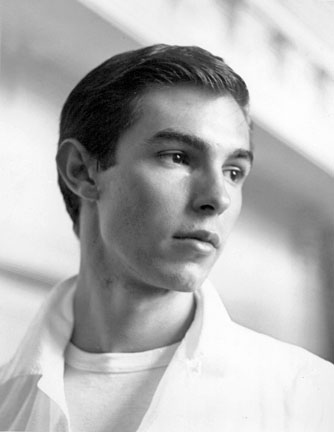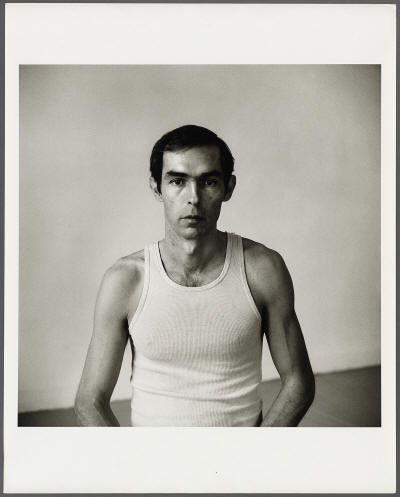Queer Places:
Louis N. Jaffe Art Theater Building, 189 2nd Ave, New York, NY 10003, Stati Uniti
Cemetery Of The Gate Of Heaven, 10 W Stevens Ave, Hawthorne, NY 10532, Stati Uniti
 Peter
Hujar (October 11, 1934 – November 26, 1987) was an American photographer best
known for his black and white portraits. Hujar's work was known for stripping
his subjects of their identity down to their innate, vulnerable forms.[1]
His photography has also been known to capture the individuality of each of
his subjects. Whether his subject was a person, animal, or object—Hujar
stressed that each is one of a kind.[2]
Peter
Hujar (October 11, 1934 – November 26, 1987) was an American photographer best
known for his black and white portraits. Hujar's work was known for stripping
his subjects of their identity down to their innate, vulnerable forms.[1]
His photography has also been known to capture the individuality of each of
his subjects. Whether his subject was a person, animal, or object—Hujar
stressed that each is one of a kind.[2]
Hujar was born in Trenton, New Jersey. Peter never knew his father, who had
abandoned Peter’s mother, Rose, and his child. Rose lived in downtown
Manhattan and worked as a waitress. When Peter was 11, he was sent to live
with his mother and her male companion. The two adults were boozers, and after
Rose threw a bottle at her son, who was then 16, Peter moved out.[3]
Because of this he was deeply insecure about his past childhood. He was raised
by his Ukrainian grandparents on their farm, where he only spoke Ukrainian
until he started school.[4]
Hujar remained on the farm with his grandparents until his grandmother's death
in 1946, when he moved in with his mother, Rose Murphy, and her second husband
who were living in New York City.[4][5]
However, the household was abusive and Hujar left to take care of himself as a
teen.[5]
Hujar is ofter described as charismatic, complicated, and deeply insecure due
to this family history.[6]
He received his first camera in 1947[7]
and attended the School of Industrial Art where he expressed interest in being
a photographer. He was fortunate to encounter an encouraging teacher, the poet
Daisy Aldan, and followed her advice of becoming a commercial photography
apprentice.[5]

Verso: stamp, "The Estate of Peter Hujar, Stephen Koch Executor, Printed by the Artist"; stamp, "Copyright 1976, The Estate of Peter Hujar, Not to be Reproduced Without Written Permission from the Estate"; stamp, "From the Estate #"; in pencil, "EPH 190-1"; signed in pencil, "Stephen Koch"; in pencil, "Self Portrait, 1976"; in pencil, "HUJ 184".

PETER HUJAR (1934-1987)
Portrait of an Agitator As a Tough Man (Jim Fouratt).
Silver print, the image measuring 342.9 mm.; 13 1/2 inches square, the sheet 419.1x355.6 mm.; 16 1/2x14 inches, with Hujar's credit, title, date, and printing notations, on a trimmed index card, print verso. 1969.

PETER HUJAR (1934-1987)
Robert Wilson, Vestry Street.
RC print, the image measuring 165.1 mm; 6 1/2 inches square, the sheet 254x203.2 mm.;10x8 inches, with the Peter Hujar Estate "Printed by the Artist" hand stamp, on verso. 1975.
Provenance: Acquired from Matthew Marks Gallery, New York; to a Private Southern Collector, in 2007.

PETER HUJAR (1934-1987)
Ethyl Eichelberger.
Silver print, the image measuring 371.5x374.7 mm; 14 5/8x14 3/4 inches, the sheet 508x406.4 mm; 20x16 inches, with Hujar's signature, title, date, edition notation 4/15, and numerical notation, in ink, on verso. 1981.
Provenance: Acquired directly from the photographer; to a private New York collector.
Exhibited in the landmark exhibition "Peter Hujar: Speed of Life," The Morgan Library and Museum, New York, January 26-May 20, 2018.
As early as 1956, Hujar began taking photographs that showed signs of his
particular style and point of view. Hujar's style is something that should be
experienced rather than just described.[8]
After meeting artist
Joseph Raffael, Hujar accompanied him on a Fulbright to Italy, where he
took many photos with the artist. In 1963, Hujar secured his own Fulbright and
returned to Italy where he explored and photographed the Palermo catacombs. On
this trip, Hujar was accompanied by his lover
Paul Thek, who would be one
of the important relationships of his life.[9]
Back in New York, Hujar was part of the downtown art scene. He was one of
the lead figures in the incoming groups of artists, musicians, writers, and
performers at the beginning of the AIDS Crisis and cultural scene in downtown
New York during the 1970s and early '80s. He was immensely admired for his
completely unyielding attitude towards his work, life, and values. He appeared
in one of Andy Warhol's
Screen Tests (which Warhol later included in a series called "The Thirteen
Most Beautiful Boys"). He worked for a spell for successful commercial
photographer Harold Krieger and shot for Harper's Bazaar and
GQ. He moved in
to his deceased friend
Jackie Curtis's loft at 189 2nd Avenue. Hujar took many photos of his
friends, combining many of them with his Palermo photos for a book called
Portraits in Life and Death, published in 1976 by Da Capo Press. The
introduction was written by his close friend
Susan Sontag and her
portrait appears in the book. Using the people in his life as subjects, Hujar
took iconic photos of Sontag,
Ethyl
Eichelberger, Candy Darling,
Divine, and his lover
David Wojnarowicz.[10]
His photograph of Darling on her deathbed in the hospital has been frequently
reproduced.
Hujar is probably best known for the work he produced during the last years
of his life before dying from AIDS-related pneumonia; his photographs from
that period document the effervescent creative spirit that pulsed through the
East Village and its environs in overlapping fields — visual art, post-punk
music-making, performance art, and political activism.[3]
Hujar was diagnosed with AIDS in January 1987, and died ten months later, on
November 25, at Cabrini Medical Center from AIDS-related pneumonia.[4][11]
Wojnarowicz was with him when he died and made a brief video recording of his
body, head to toe, and took 23 photographs.[12]
While on his deathbed, Hujar shot photographs of Wojnarowicz in his final
attempt to capture life through the lens of a camera.[13]
Per Hujar's wishes, his funeral was held at Church of St. Joseph in Greenwich
Village.
He is buried at Gate of Heaven Cemetery, Valhalla, New York.[14]
My published books:


BACK TO HOME PAGE

- https://en.wikipedia.org/wiki/Peter_Hujar
- Hidden Histories, 20th Century Male Same Sex Lovers in the Visual
Arts, by Michael Petry
 Peter
Hujar (October 11, 1934 – November 26, 1987) was an American photographer best
known for his black and white portraits. Hujar's work was known for stripping
his subjects of their identity down to their innate, vulnerable forms.[1]
His photography has also been known to capture the individuality of each of
his subjects. Whether his subject was a person, animal, or object—Hujar
stressed that each is one of a kind.[2]
Peter
Hujar (October 11, 1934 – November 26, 1987) was an American photographer best
known for his black and white portraits. Hujar's work was known for stripping
his subjects of their identity down to their innate, vulnerable forms.[1]
His photography has also been known to capture the individuality of each of
his subjects. Whether his subject was a person, animal, or object—Hujar
stressed that each is one of a kind.[2]





